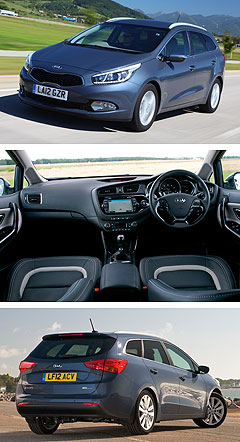Paris show: Kia considers Euro hot hatch for Oz
BY RON HAMMERTON | 1st Oct 2012

Designed primarily for Europe, the Pro_cee’d was not considered a likely contender for Australia, partly because Kia’s European plant in Slovakia was expected to be stretched to supply sufficient numbers to Europe, let alone export demands.
But with the recession biting in Europe and the Australian dollar strong against the Euro, the Astra GTC-style hatch is under consideration, along with the related Cee’d Sportwagon.
Kia Australia national public relations manager Kevin Hepworth said the Pro_cee’d was now on the radar for Australia, but that nothing had been finalised.
“We don’t even have a piece of paper yet,” he said.
However, the five-door Cee’d hatch is off the agenda, as Kia Motors Australia considers it conceptually too close to the Korean-built Cerato, the third generation of which is due to be rolled out in Australia in 2013 in five-door, sedan and Koup configurations.

The Cee’d is more upmarket than the Cerato, and designed to compete with the likes of the Volkswagen Golf and Renault Megane in Europe.
But Kia Australia can see a niche for the bob-tailed three-door version that goes on sale in Europe around May next year, especially when it gains a hot turbo-charged petrol engine to fulfil its sporting promise.
The Pro_Cee’d will be launched in Europe with a choice of four basic engines – two diesel and two normally aspirated petrol – in 1.4-litre and 1.6-litre guises with power ratings ranging from 66kW to 99kW.
But Kia Motors marketing vice president Benny Oeyen assured journalists that those engines would not be the end of the story for Pro_cee’d.
“Stay tuned for more Cee’d action in the near future,” he said.
The most likely turbo engine for the Pro_cee’d is the Gamma 1.6-litre T-GDI four-cylinder powerplant that currently powers the Hyundai Veloster SR Turbo, but probably with more power and torque in its Kia form.
In the Veloster SR Turbo, that engine produces 150kW of power at 6000rpm and 265Nm of torque between 1750 and 4500 rpm.
As well as powering flagship sports Pro_cee’d hatch, the engine is also set to find its way into the Cerato Koup in its next generation at some point.
The Pro_cee’d was launched alongside the related Rondo small people-mover at the Paris show on Thursday, while the Cerato Koup is likely to surface at the New York motor show in April.
The seven-seat Rondo will be launched in Australia about April, and like the Cerato range, will be made in South Korea for the world.
The Pro_cee’d is part of the European-designed, Slovakian-buit Cee’d family that also includes the five-door Cee’d hatch and Cee’d Sportswagon that is also under consideration for the same reasons as the Pro_cee’d.
If a business case can be made, that five-seat wagon might shape up as a rival for the likes of Holden’s Cruze wagon in Australia.
Kia’s parent company Hyundai withdrew its European-built i30 small wagon from Australian sale when it launched its new-generation model earlier this year, despite the old model accounting for around 20 per cent of total sales.
Kia is the fastest-growing car brand in Europe this year, with sales growing 23 per cent so far this year.
But even with that explosive growth, the general car market malaise in Europe is tempting Kia to consider alternative markets such as Australia.
The premise that Pro_cee’d will get a high-performance engine to match its racy looks was supported by comments from Kia design director Peter Schreyer when talking with Australian journalist at last week’s Paris motor show.
He said the Pro_cee’d warranted “a decent engine”.
The Pro_cee’d and Rondo are among 51 new and updated vehicles being launched by Kia globally over the next four years.
Despite the huge workload for Kia’s design team of between 200 and 250 workers – small by world standards – Mr Schreyer says he was planning only a modest expansion of his design network that includes studios in South Korea, Germany and California.
He said he would retain only those three studios as Kia grew so he could maintain the styling direction for Kia.
“The more design centres you have, the harder it is to maintain design direction,” he said.